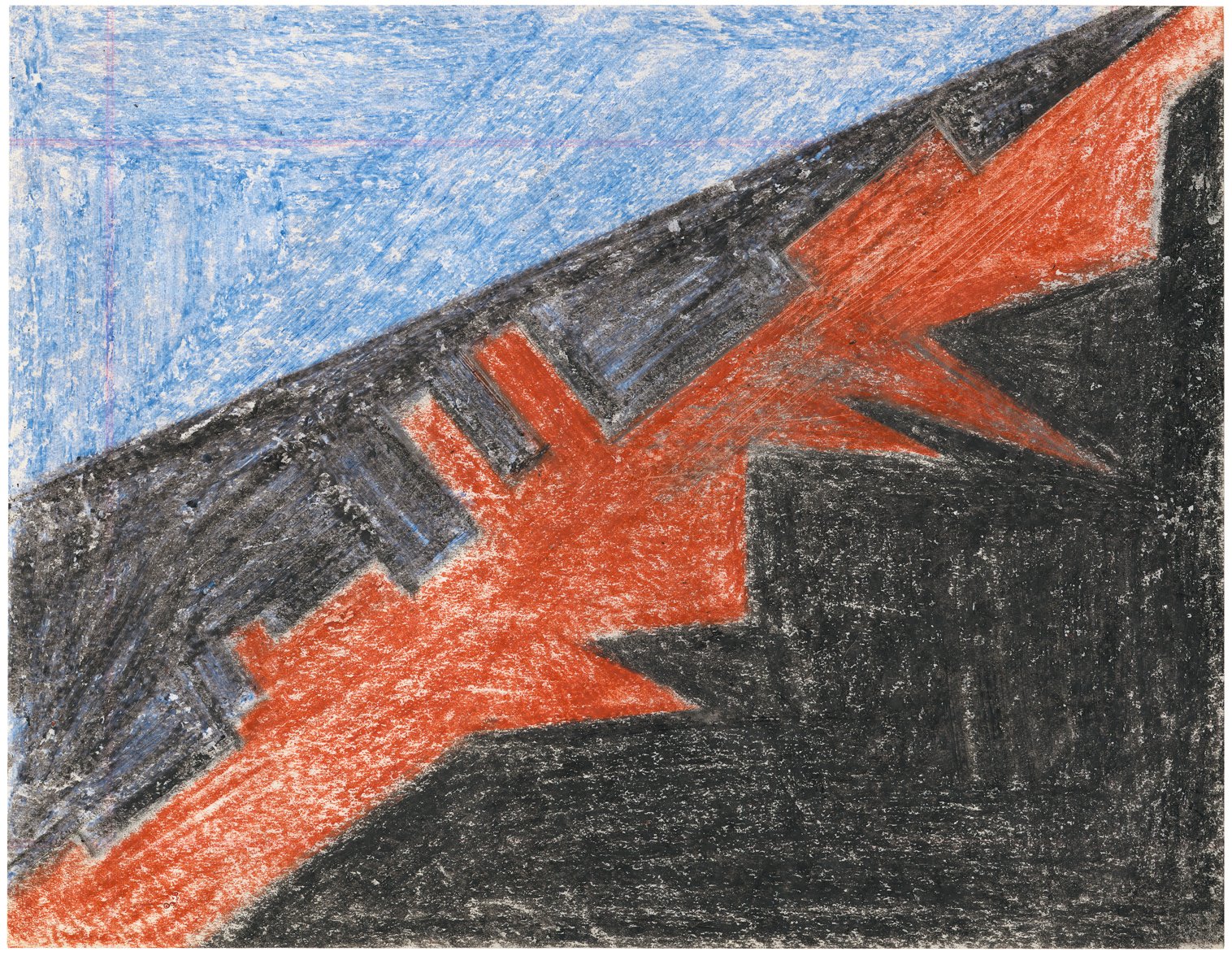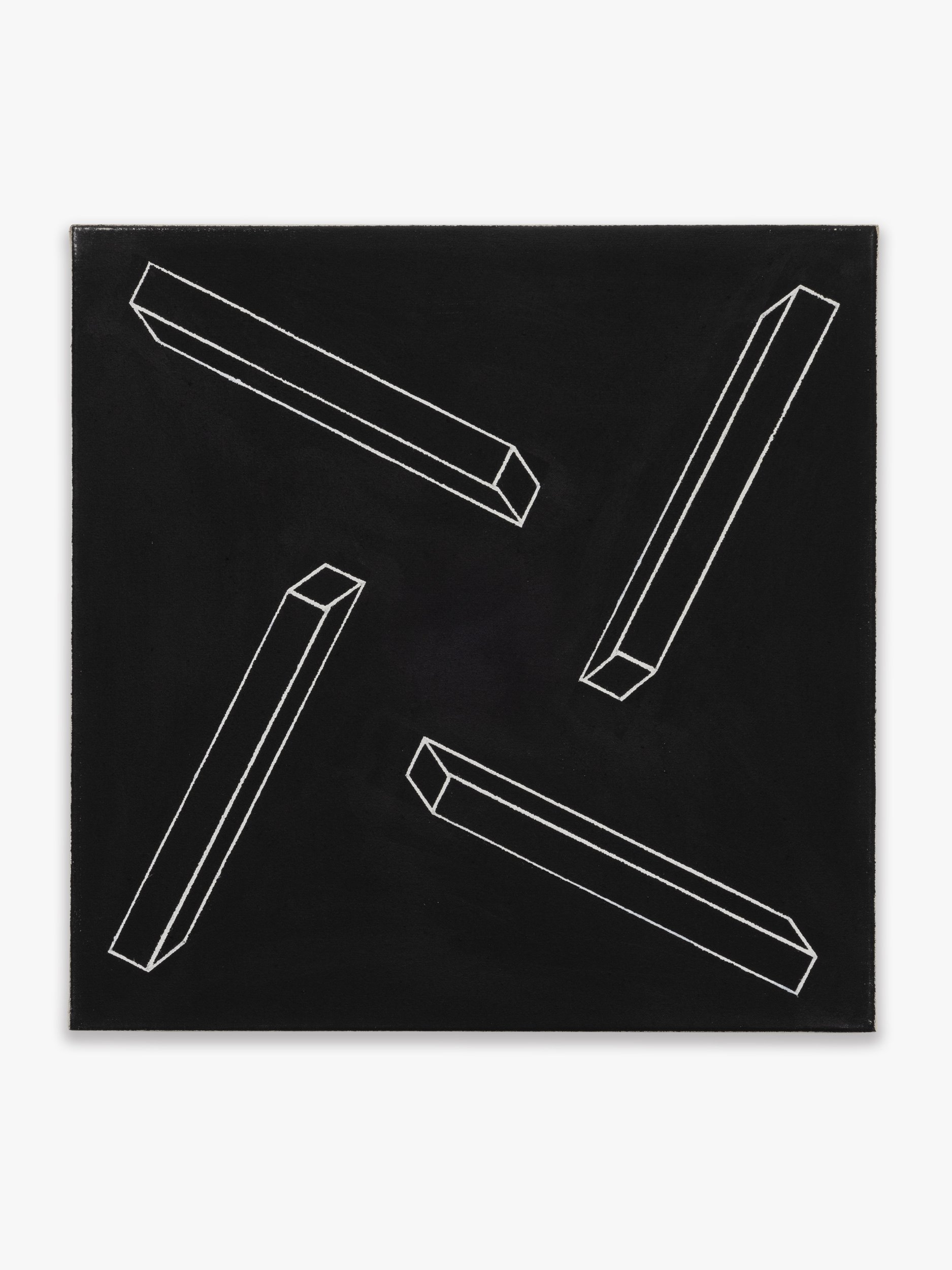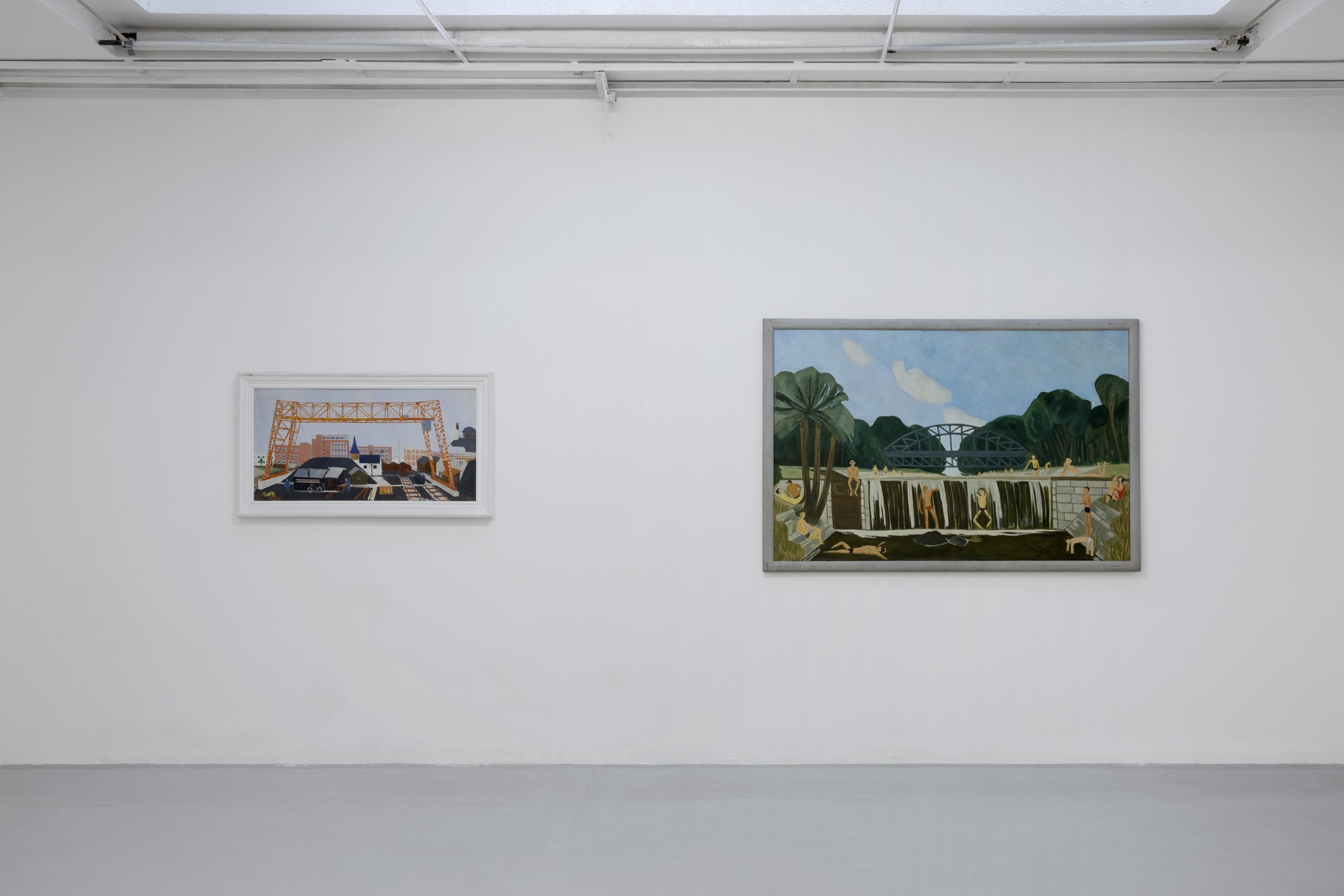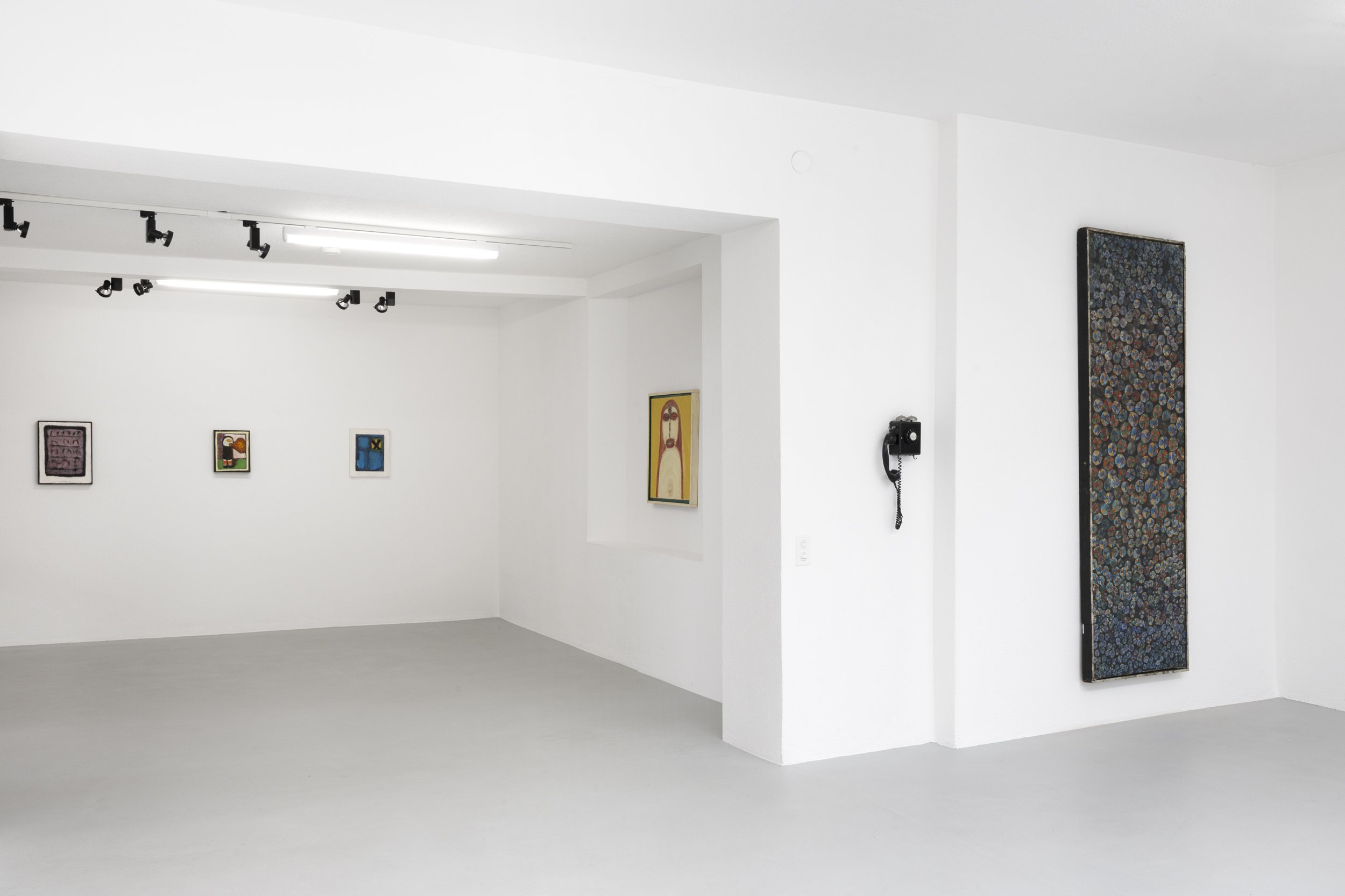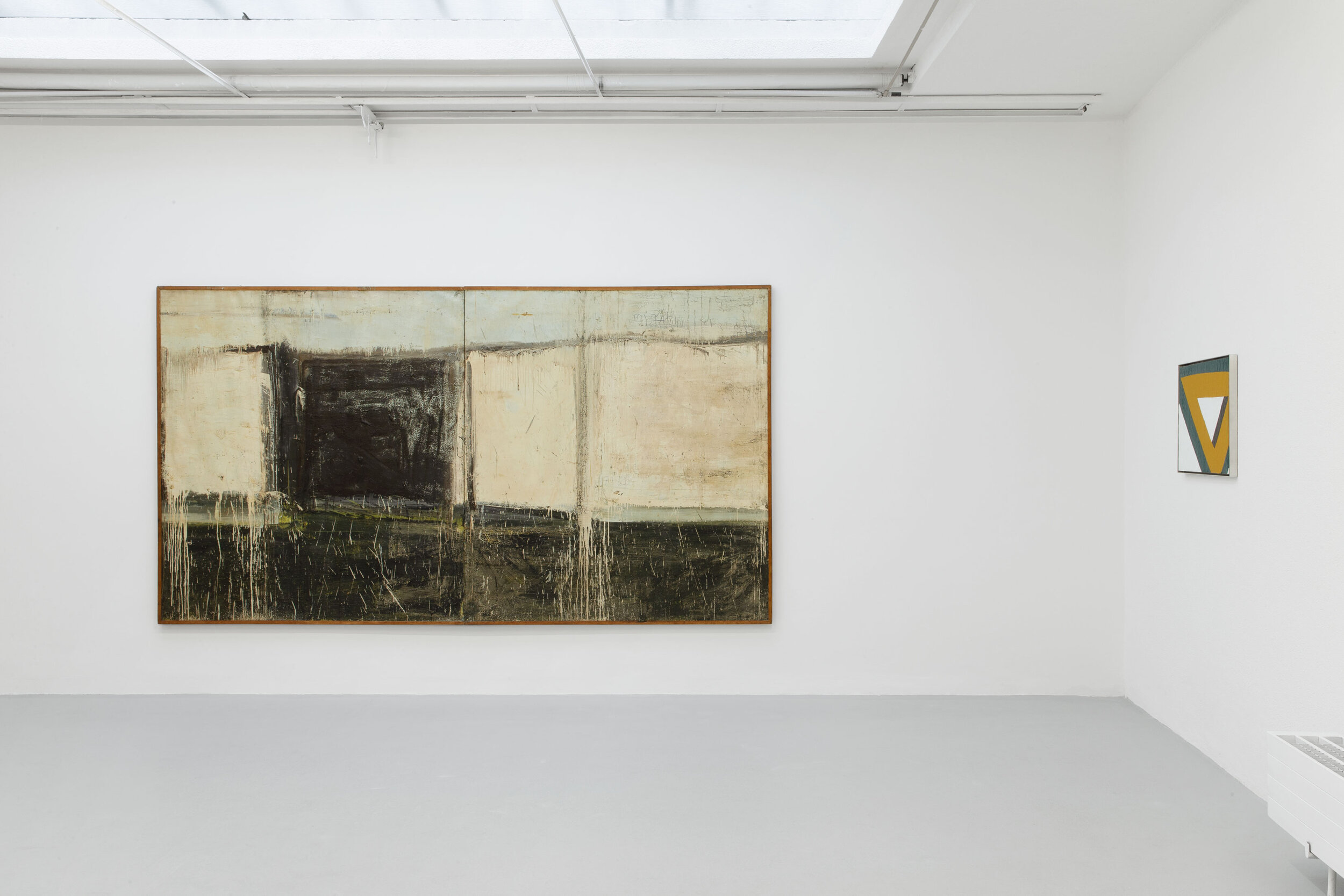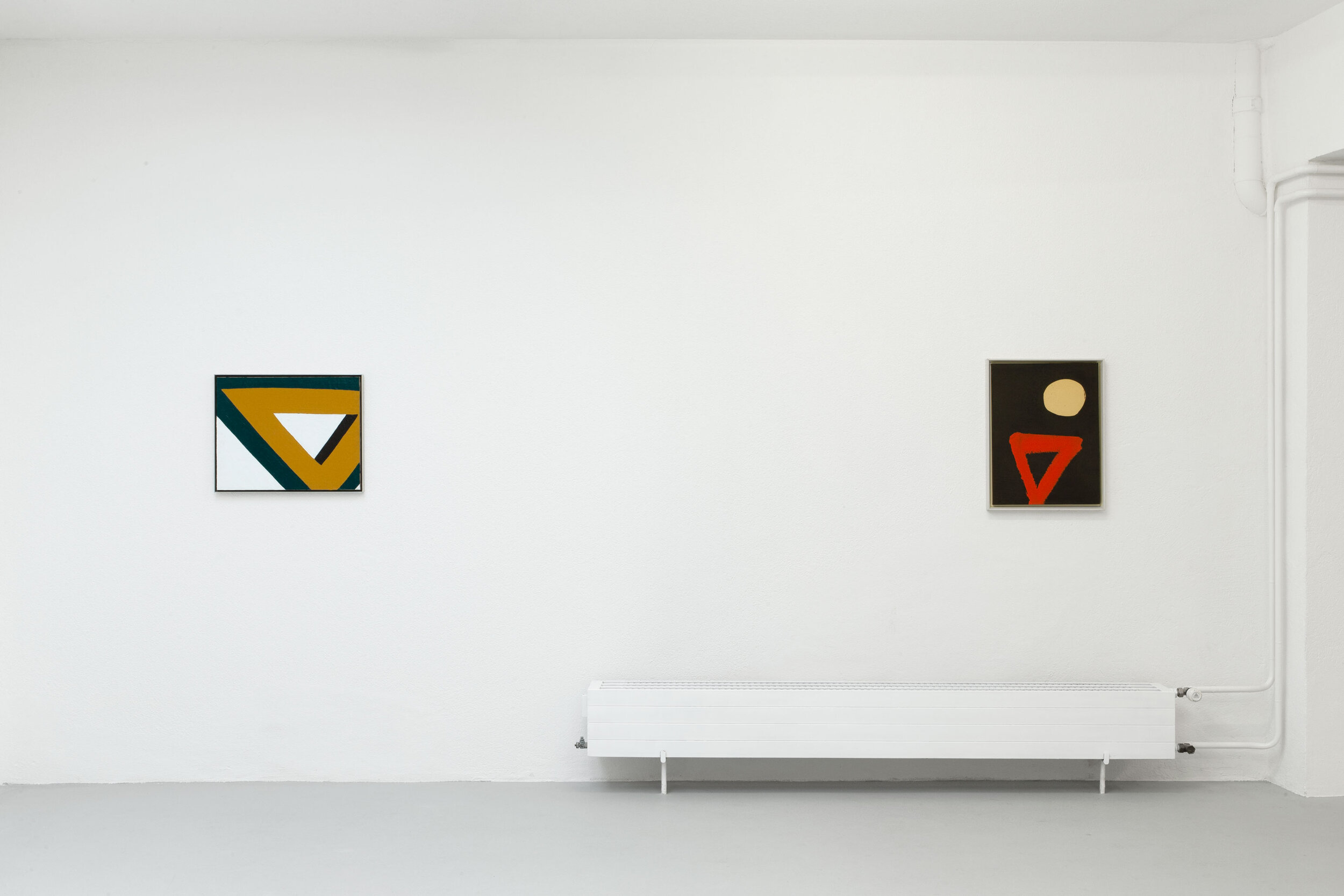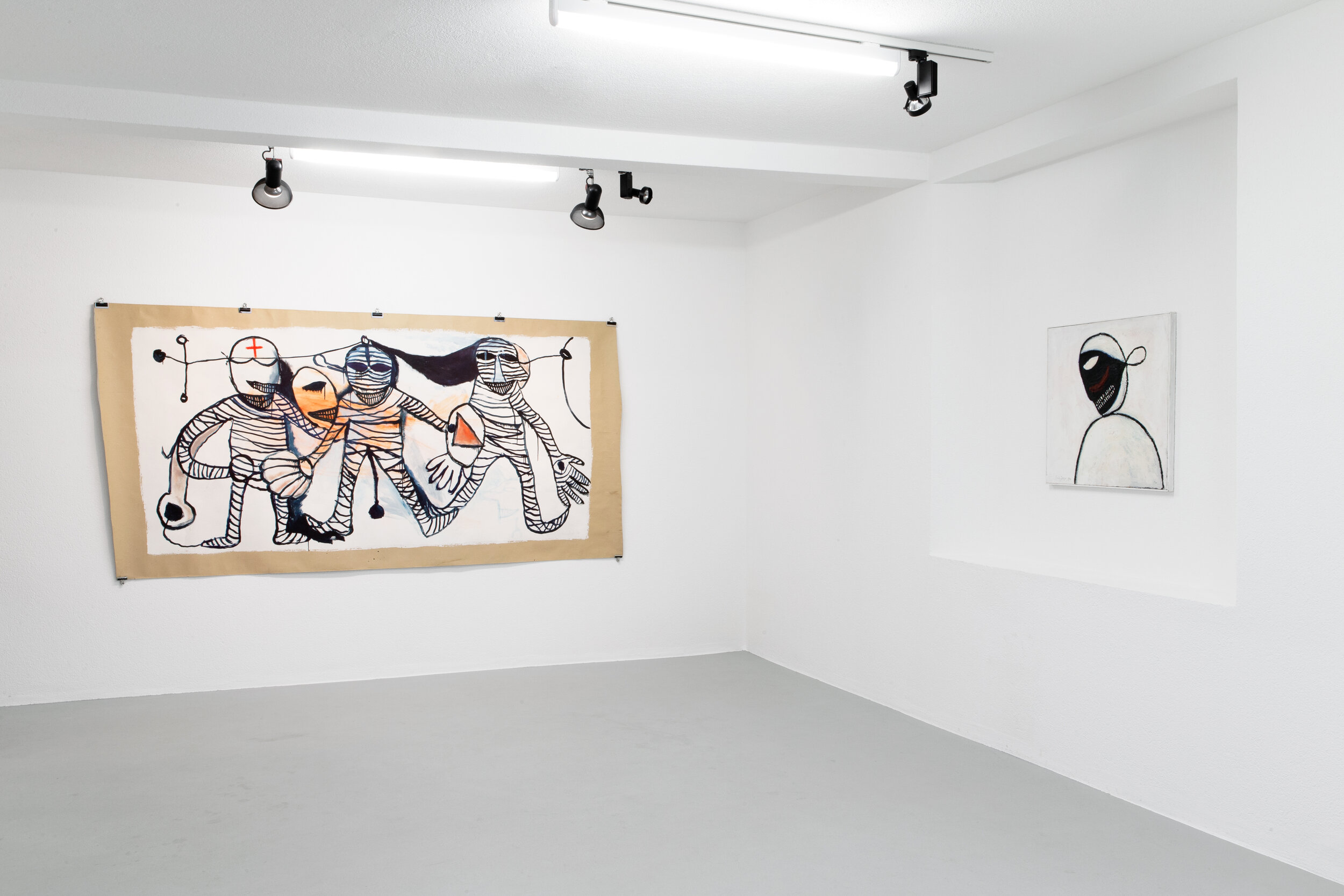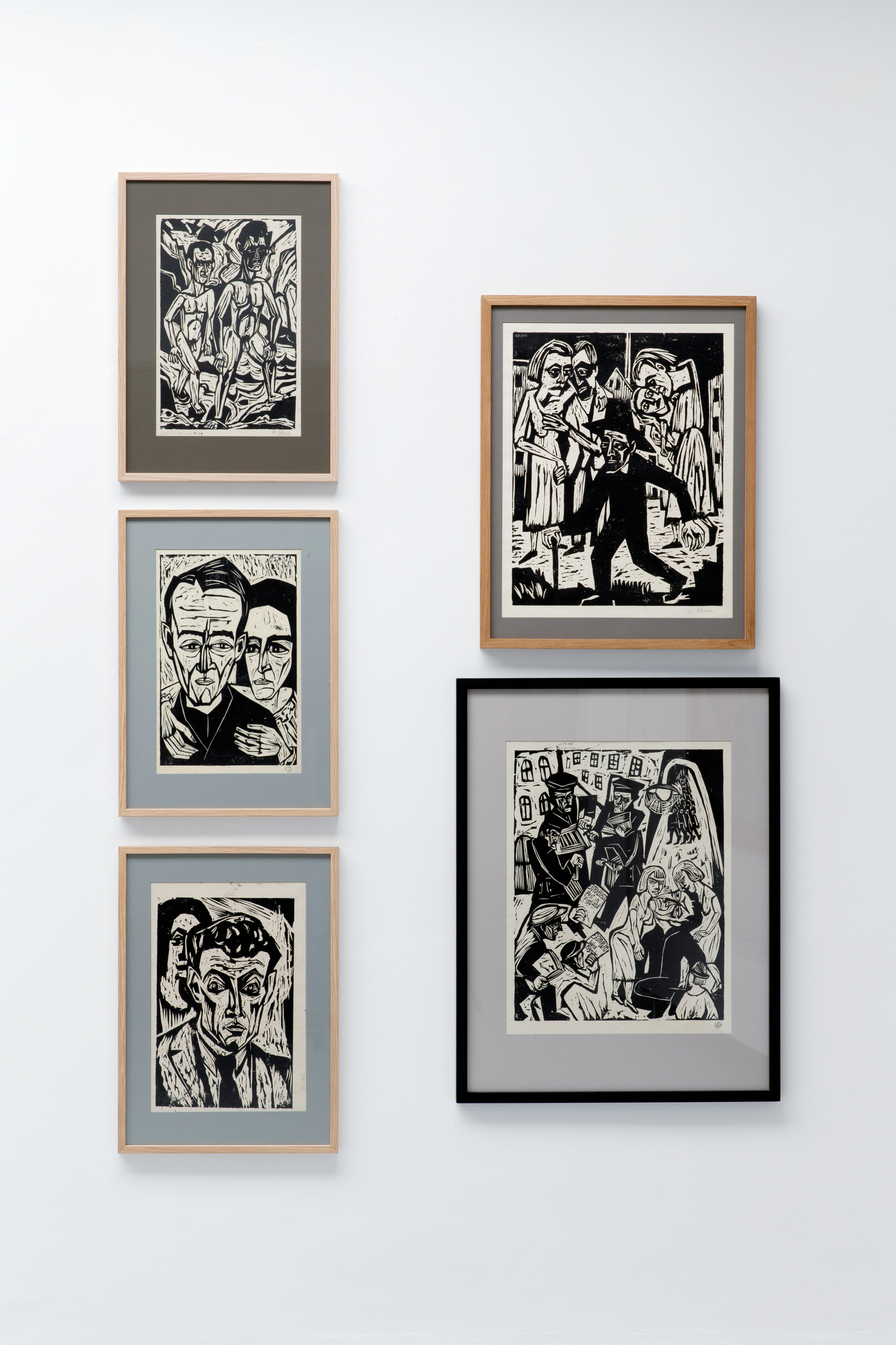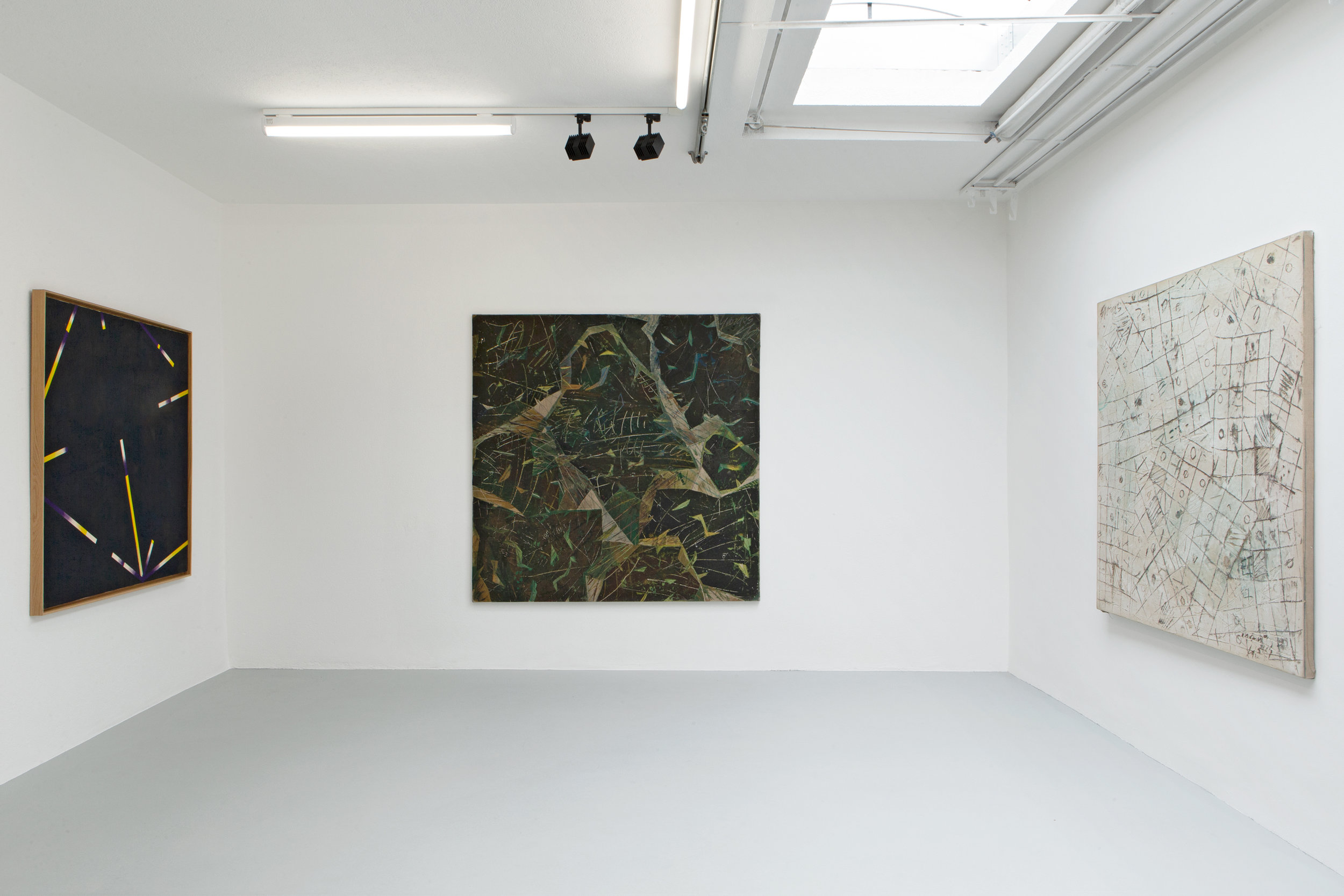signals
(4.4. - 28.6.2025, opening April 4th from 5pm)
Hear the Signals!
"Two considerations and notions stood at the inception of this show, one positive and one negative. The positive: awareness of the work of some painters, the exhibitionary presentation of which practically imposed itself upon me. The negative: a certain helplessness in the face of the artificially overstimulated art world, the hectic coasting in neutral and the organized hubbub. Perhaps – like the artists exhibited here – I also felt aneed for order and a clarification of perspectives."
Arnold Rüdlinger, opening speech Signale (1965), Kunsthalle Basel
The exhibition Signale was dedicated to painting that has sometimes been canonized as "hard edged" – that is,mainly large-format, geometric painting. It paired works by Kenneth Noland, Al Held, Jules Olitski, and Ellsworth Kelly with paintings by lesser-known European artists such as Hansjörg Mattmüller, Georg Karl Pfahler, John Plumb, and William Turnbull. This was a strategy that Harald Szeemann, Rüdlinger's protegé and later successor in Bern, often used too.
In 2025, 60 years after this important exhibition, Galerie Mueller is out on a search for clues. The exibition with the English title Signals combines works by the Swiss Theodor Bally and Luigi Lurati, the German Georg Karl Pfahler and the three Americans Al Held, Kenneth Noland and JulesOlitski. Galerie Mueller is thus expanding its research into the transatlantic dialog in post-war art.
A publication is available free of charge at the gallery.
LA FONTAINE DE LA MORT
(6.12.2024 - 1.3.2025)
Based on Jean Tinguely's late masterpiece La Fontaine de la Mort I (1989) and the well-known vanitas motif in art history, the exhibition brings together a wide variety of artistic positions from the beginning of the 20th century to the present day.
With works by:
Jean Tinguely, Horst Antes, Nicolas Guagnini, Klaudia Schifferle, Eva Aeppli, Gabriella Gerosa, Franz Karl Basler-Kopp, Paulo Nazareth, Werner von Mutzenbecher, Miriam Cahn, Anna Barbara Wiesendanger, Gustav Stettler, Jimmy DeSana, Katinka Bock, Rudolf Maeglin, Hermann Scherer, Eva Kotátková, Andreas Walser, Niklaus Hasenböhler, Jonathan Monk, Johannes Robert Schürch
A publication is available free of charge at the gallery.
Jean Tinguely's work La Fontaine de la Mort I (L'Ermitage) can be viewed on the following dates at Mailand-Strasse 41 on the Dreispitz: December 7th and 14th, 2024 between 11-12 a.m., or by appointment (contact: julia.cellarius@galeriemueller.com).
JEAN TINGUELY.
SKULLS AND BONES
(30.8. - 08.11.2024)
The exhibition Skulls and Bones is dedicated to the final years of Jean Tinguely's work, during which his profound connection between art and life became particularly striking.
This connection is especially evident in his later works, which he continued to create with unwavering passion despite health issues until his death in 1991. In the last five years of his life, Tinguely produced impressive sculptures and installations, often addressing the theme of transience.
Galerie Mueller presents a selection of these late works, including the remarkable machines Deng Xiao Ping III (1990) and Le Cercle Infernale de la Mort (1990). These pieces highlight Tinguely's relentless dedication and his ability to artistically explore deep and complex themes.
A publication is available free of charge at the gallery.
KLAUDIA SCHIFFERLE
DIE TIERE DIE TÜRE
(25.5. - 13.7.2024)
Galerie Mueller and Weiss Falk are pleased to show Klaudia Schifferle Die Tiere Die Türe, curated by Reto Thüring, taking place across both galleries.
Influenced by the feminist ideas of the post-punk, new wave and indie scene of the 1970s, Klaudia Schifferle has always moved intuitively and uncompromisingly between different media, techniques and stylistic concepts. Schifferle‘s (visual) language knows hardly any boundaries and yet is clearly delineated; firmly held together by an artist who has had her finger on the pulse of time for 50 years, exploring the human condition in her own language.
The exhibition Die Tiere Die Türe is divided into two chapters. At Galerie Mueller, works on paper from the late 1970s to the early 1990s will be on display. Weiss Falk is showing works from the past five years. The overarching theme is metamorphosis as a symbol of an understanding of the world and art in which man and nature, self and environment are inextricably intertwined and in constant exchange. Die Tiere Die Türe is the first major juxtaposition of new and older works by Klaudia Schifferle.
The exhibition will be accompanied by a monographic book published by Hacienda Books, providing insight into her work from its beginnings to the present.
streifjagd
(2.3. - 27.4.2024)
With the group exhibition Streifjagd Galerie Mueller continues its exploration of the recent history of Basel's art scene. The selected works of the five artists span from 1980 to the 1990s. Unlike the 2022 MAYBE IT’S ALL A BIG MISTAKE exhibition, this time the emphasis is not on a specific decade of Basel's art history but more on abstract painting and drawing. The exhibited artists Helmut Federle, Ueli Michel, Werner von Mutzenbecher, Karim Noureldin, and Marcel Schaffner had a connection to the Allgemeine Gewerbeschule at some point in their careers, either as teachers or students. Besides the Kunsthalle Basel, the school played a central role, a significance that persists to this day and has even expanded.
Helmut M. Federle Bilder 1977–78 was Ammann's first exhibition during his tenure at the Kunsthalle Basel. The reduced, cool, and abstract formal language in small-format paintings left a lasting impression on many artists. Ammann continued the exploration of this new (geometric) abstraction with the solo exhibition of Werner von Mutzenbecher in 1981, focusing on the black and white acrylic paintings of the young Basel artist. The works of Marcel Schaffner and Ueli Michel on paper and canvas exhibit a different abstract formal language. Schaffner had been represented in group exhibitions at the Kunsthalle Basel several times and, like Werner von Mutzenbecher initially, came from lyrical abstraction. The time with Arnold Rüdlinger at the Kunsthalle Basel and the influence of the American painters he showcased had a lasting impact on him. Ueli Michel developed a distinctive abstract form and painting language, skillfully translating it onto canvas and paper, both in painting and drawing. The youngest of the five, Karim Noureldin, received his education at the Allgemeine Gewerbeschule in Basel and knew Werner von Mutzenbecher and Ueli Michel from school. Additionally, he exhibited in the early 1990s at the Galerie Elisabeth Kaufmann, which also featured Helmut Federle. The large group of small-format drawings is exhibited in this form for the first time. They are enchanted beings and forms between fantasy and reality, abstraction, and figuration.
A catalogue is available free of charge at the gallery.
90 JAHRE GRUPPE 33
(24.11.2023 - 26.01.2024)
Seeking for more clout among the established and older generation of artists, various associations of contemporary artists were formed in Switzerland towards the end of the 19th and beginning of the 20th century. In Basel in particular, associations or groups such as Das Neue Leben, Rot-Blau, Kreis 48 and Gruppe 33, which would have celebrated its 90th anniversary this year, were formed. Gruppe 33 presented its works to the public for the very first time at the Weihnachtsausstellung (Christmas exhibition) of 1933, followed by presentations outside Basel, at the Palais de Rumine in Lausanne, in Paris at the Galerie Kléber, and later numerous other exhibitions at the Kunsthalle back in Basel.
With protagonists such as Otto Abt, Walter Bodmer, Paul Camenisch, Theo Eble, Karl Hindenlang, Daniel Hummel, Rudolf Maeglin, Enst Max Musfeld, Meret Oppenheim, Kurt Seligmann, Walter Kurt Wiemken and Irene Zurkinden, Gruppe 33 made decisive contributions to modern art giving the avant-garde a presence and impact in Switzerland.
The exhibition shows surrealistic, neo-objective, constructivistic, realistic and abstract as well as non-objective positions. Without a claim to historical relevance or completeness, focusing entirely on the sovereignty of the exhibits.
A catalogue is available free of charge at the gallery.
KONKRET. AREND FUHRMANN,
KARL GERSTNER,
VERENA LOEWENSBERG,
HEDI MERTENS
(25.8.-28.10.2023)
In Switzerland, concrete art has a high status and is well known. Although it is an art form with roots in the early 20th century, its continuation is also important for 21st-century Switzerland. Or to put it another way: The concept may have become historical, but the content is very current. Here, colours, shapes, lines and geometry constitute properties of surfaces on paper, canvas, metal or stone. The manner in which these can be experienced is primarily defined by the sensory factor, the observer’s individual perception of what is shown and what ultimately represents the non-visible world.
The exhibition Concrete. Arend Fuhrmann, Karl Gerstner, Verena Loewensberg, Hedi Mertens is an attempt to unite Fuhrmann and Mertens, two artists who, especially today, are not particularly well known, with Gerstner, an artist rarely counted as part of the circle of concrete artists, and with Loewensberg, thus forming a direct link to one of the movement’s most important artists.
A catalogue is available free of charge at the gallery.
With works by Arend Fuhrmann, Karl Gerstner, Verena Loewensberg, Hedi Mertens
junge kunst 1969.
kurt fahrner,
fridrich kuhn,
hans schärer,
philipp schibig
(6.5.-1.7.2023)
The show Junge Kunst 1969. Fahrner, Kuhn, Schibig, Schärer, Galerie Mueller takes its cue from past exhibitions by art historian Jean-Christophe Ammann. As part of the format, originally established by Peter F. Althaus, Amann showed a group of two to four young artists at Kunstmuseum Luzern in year 1969. Ammann decided on a very personal selection and staged each of the artists alone, so to speak, and yet in the group under what he called a "fantastic-surrealist" veil. On the basis of a few significant groups of works, the work of the individual artists was to be documented within a period of time and shown in a superordinate, intellectual framework in the mutual demarcation or affiliation. Galerie Mueller continues its exploration of the work of Hans Schärer and Philippe Schibig with a reprise of the exhibition Junge Kunst from 1969, combining these two positions with works by Kurt Fahrner and pieces by the Zurich Enfant Terrible Friedrich Kuhn.
A catalogue is available free of charge at the gallery.
With works by Kurt Fahrner, Fridrich Kuhn, Hans Schärer and Philipp Schibig.
hommage à anton meier
(11.2.-1.4.2023)
All works in the exhibition Hommage à Anton Meier at Galerie Mueller come from the estate of Galerie Anton Meier. With this exhibition and the small publication, Galerie Mueller is, on one hand, paying tribute to the tireless work and important contribution of Anton Meier and Galerie Anton Meier to contemporary art in Switzerland. On the other hand, the programs of the two galleries overlap significantly, especially with regard to Lucerne painter Hans Schärer. This cooperation with Anton Meier’s estate is set to continue in the longer term.
OWSKY KOBALT
(5.11.-23.12.2022)
For most of her life, the artist lived and worked in seclusion in a quarry in Baselland, which was the center of her life and artistic work. After "the discovery of her life", sculpture, she was able to devote herself entirely to her passion and vocation there in her self-built house and specially equipped workshops. Although she studied sculpture, she had learned the carving of stone by herself. All the more astonishing was her accuracy and precision in the realization and completion of her sculptures. All objects are unique pieces, handcrafted to the end, whether made of stone, metal or wood. In addition to these technical qualities, the playful component in her work stands out, which was and is inherent in many of her objects.
Through various commissions and participation in competitions, many of her works can be seen to this day in Basel, the region as well as in other localities in Switzerland. Not only geometric and architectural forms, but also found artifacts from nature played an important role in the search for form and shaping of her objects.
Kobalt participated in numerous solo and group exhibitions. She also exhibited her work at the Kunsthalle Basel, for example "das Schlafende Auge, das erst nach jahrelanger Ruhe zum Sehen kommt", a beautiful work, which is now in the Esther Grether collection. Die Perle (1989) by the Wettsteinbrücke or Die Lichtung (1993-94) in the Gellertgut-Park are also well-known works in Basel's public space that are well worth seeing.
The last major presentation of her works dates back to the 1990s. A larger institutional appreciation of her work has so far remained elusive. With more than thirty exhibits, we are showing a representative cross-section of Owsky Kobalt's work for the first time in the new millennium.
sonja Sekula
(14.5.-2.7.2022)
Born in 1918, the artist was highly regarded for some time, but after her tragic death in 1963, her works mostly circulated in narrow circles only, and little was known about her biography, even in her native Switzerland. Her status as one of the most significant 20th-century Swiss artists did not become clear until the 1996 retrospective at Kunstmuseum Winterthur, with its thoroughly documented catalog. In the new millennium, two group exhibitions at Aargauer Kunsthaus (2008) and Kunstmuseum Lucerne (2016) attempted to follow suit.
Sekula’s oeuvre is central to recent Swiss art history. Her work progressed in line with key mid-century artistic developments—surrealism and American abstract expressionism — and she carved out her own distinctive position in this context. This was confirmed when the Museum of Modern Art in New York reopened in 2019 and hung Sekula’s painting The Town of the Poor (1951), purchased one year earlier,in the room dedicated to abstract expressionist painters in its collection. In Switzerland, this level of recognition is yet to be seen.
The exhibition is accompanied by a publication with texts by Dieter Schwarz and Griselda Pollock, images and a list of works.
may be it’s all
a big mistake
(12.2.-9.4.2022)
Please join us on February 11 for the opening of May Be It's All a Big Mistake at Galerie Mueller. The exhibition refers to a series of shows by Swiss curator Jean-Christophe Ammann in the 1980s at Kunsthalle Basel. On display are 34 works from this seminal period. The exhibition title is a quote from an invitation card by the artist Rut Himmelsbach from 1985. Ammann's exhibitions such as Artists from Basel (1981) played a central role in the careers of artists like Miriam Cahn, Rut Himmelsbach, Alex Silber and Vivian Suter. Also part of the exhibition is a representative group of works by Werner von Mutzenbecher as an advocate of an older generation - Ammann showed him in a solo exhibition in 1981 - and Silvia Bächli, whose works were exhibited by Ammann in 1987. In addition, the exhibition includes works by Martin Disler from the late 1970s, whose progressive voice left its mark on the Swiss art scene of the time like no other.
The exhibition is accompanied by a publication with text, images, a list of works and an essay.
With works by Silvia Bächli, Miriam Cahn, Martin Disler, Rut Himmelsbach, Werner von Mutzenbecher, Alex Silber and Vivian Suter.
MAX SULZER
1926-2013
(27.11.-12.12.2021)
Galerie Mueller for the first time shows an extensive overview of paintings by Basel artist Max Sulzer. The exhibition was conceived and realized in cooperation with the family and estate of the artist.
new wild
artists
(11.9.-13.11.2021)
In the late 1970s and early 1980s, a new phenomenon in painting emerged on the German art scene: large-format canvas works, figurative portrayals and boisterous use of color. These mostly young painters presented a “rich world of motifs, oscillating between direct wit and a relish for provocation”. A stark contrast to the prevailing art movements of the time, such as minimal or conceptual art. One important feature of this loose stylistic movement was its early geographical fragmentation, with a multitude of protagonists. Jean-Christophe Ammann, curator of Kunsthalle Basel, showed the German wild or violent painters early on in his tenure in Basel. The exhibition is an homage to this time and a dispute with a type of painting with its roots at the beginning of 20th century and finds suitors also in today’s contemporary art.
The exhibition is accompanied by a publication with text, images, a list of works and an essay.
With works by Walter Dahn, Martin Disler, Jiri Dokoupil, Niklaus Hasenböhler, Karl Horst Hödicke, Leiko Ikemura and Markus Lüpertz.
rudolf maeglin
(20.3.-12.6.2021)
In spring 2021 Galerie Knoell, Nicolas Krupp and Galerie Mueller host the first retrospective of the Basel painter Rudolf Maeglin (1892-1971). The exhibition will take place in all three galleries.
Accompanying the exhibition the monograph Rudolf Maeglin. Painter was published with Christoph Merian Verlag.
Galerie Knoell, Galerie Nicolas Krupp, Galerie Mueller (Hg.), Rudolf Maeglin. Maler / Painter, 2021, 268 Seiten, 126 meist farbige Abbildungen, broschiert, 20,5 x 29 cm, Deutsch/Englisch, ISBN 978-3-85616-941-1, CHF 36 (in der Galerie erhältlich)
Johannes robert schürch
comédie humaine
(26.11.2020-6.2.2021)
The exhibition Johnanes Robert Schürch. Comédie Humaine for the first time in Basel and in the year of his 125th birthday shows to an extensive degree the work of the Swiss painter and draftsman Johannes Robert Schürch (1895-1941). The focus lies exclusively on his works on paper.
The exhibition was organized in close collaboration with the Erica Ebinger-Leutwyler-Foundation in Lucerne, which looks after and manages the estate of Johannes Robert Schürch.
Accompanying the exhibition a catalogue is published with images of the works and the essay “Johannes Robert Schürch. Zum 125. Geburtstag” by Beat Wismer, art historian, art critic and author from Zurich.
arnold rüdlinger.
new american
painting
(5.9.-30.10.2020)
The exhibition Arnold Rüdlinger. New Marican Painting is a trupute to the famous Swiss curator Arnold Rüdlinger (1919-1967). He was one of the most prolific and progressive exhibition makers in the after war period in Europe and a trailblazer and advocate for informal painting and the American abstract expressionism. This was heavily reflected in his exhibition activities as a curator of Kunsthalle Bern and Basel. With strong conviction and great success he committed himself to the new tendencies of new American painting and also exhibited those. In 1959 he landed a coup in mounting a double exhibition at Kunsthalle Basel. In the Oberlichtsaal he showed the first monographic exhibition of Jackson Pollock, while in the downstairs rooms were devoted to the survey “New American Painting” which united all the important exponents of this tendency. His fascination with US-art was rooted with the work of and friendship with Alexander Calder, whom he had already shown during his tenure in Bern in the 1950s. Rüdlinger consequently stayed on this path and also showed the second generation of abstract expressionists around his friend Sam Francis, which included artists like Shirley Jaffe, Joan Mitchell, Kimber Smith, Al Held or Jean-Paul Riopelle. The exhibition at Galerie Mueller brings together diverse positions of new American art and through this follows in the footsteps of Arnold Rüdlinger and his legacy.
The exhibition is accompanied by a publication with text, images, a list of works and the essay “Bold Gestures” by the Berlin based critic and author Camila McHigh (*1993, California) and is available at the gallery.
With works by Alexander Calder, Sam Francis, Al Held, Shirley Jaffe, Alfred Julio Jensen, Alfred Leslie, Barnett Newman and Kimber Smith.
hans schärer.
pandemonium
of the masks
(8.2.-20.6.2020)
The exhibition Hans Schärer. Pandemonium of the Masks is the first solo show with works by Hans Schärer (1925-1997) in the city of Basel. It is also one of the few chances to see his late works that he made in the 1980s and 1990s. The main focus of this show lies on two of his large oil drawingson paper, some big paintings on canvas and smaller watercolors on paper. It’s a selection that not only traces Schärers passion for painting and color but also gives the viewer a glimpse into his magnificent, grotesque, lively and bizarre world of images. The mask or grimace is central to this world and appears in this exhibition in all its varieties, sizes and manifestations. The exhibition explicitly does not lay the focus on Schärers most prominente series of works entitled Madonnas, which he produced over a time span of roughly twenty years but stopped shortly before the works that are on display in this show started to came to arise.
The exhibition is accompanied by a publication with text, images and a list of works and is available at the gallery.
With works by Hans Schärer.
remember to expand
(9.11.-23.11.2019)
The exhibition remember to expand is a cooperation with Kathrin Eckhardt Studio (Zürich/Accra). Especially for the show Kathrin Eckhardt created eleven basket-objcts as single pieces in Accra, Ghana. In cooperation with Galerie Mueller matching and complementing historic works of art have been selected for presentation.
With works by El Anatsui, Miriam Cahn, Alfonso Hüppi, Willi Müller-Brittnau, Tadaaki Kuwayama und Lynette Yiadom-Boakye.
Dunkel i hell.
ein kapitel basler kunst
(7.9.-2.11.2019)
For the first time in exhibition history Galerie Mueller pairs the two groups of Basel painter “dunkeltonig” and “rot-blau”. The oldest work in the exhibition in a style comparable to French Realism dates back to 1905. The first work in a new styl for Basel comparable to German Expressionism dates from 1925. The exhibition researches these two groups, their affiliations and differences and presents works on paper and canvas.
With works by Paul Basilius Barth, Numa Donzé, Jean-Jacques Lüscher, Heiggi Müller, Albert Müller, Hermann Scherer, Otto Staiger, Otto Roos.
georges noël
(18.5.-6.7.2019)
Georges Noël (1925-2010) is one of the most prominent French painters and sculptors of the second half of the 20th century. He was born in the Pyrenees mid 1920s and moved to Paris to become a painter aged thirty where after acclimatising successfully he started working on his first important series of paintings Palimpsestes. By the end of the 1950s he was discovered by the reknowned Parisian art dealer Paul Facchetti who included works of Noël’s first in group shows and in 1960 installed his first solo show in Paris. Out of this grew a successful partnership and Noël developed his painting, which was and would always be based on a stupendous technique mixing pigments with paste. By the end of the 1960s Noël left Paris for the US, first to Minneapolis, later to New York, where in a totally different environment he conceived new language in his paintings and also new content and references. In the 1970s h showed his works in The Pace Gallery in New York and was thriving commercially and artistically. At the beginning of the 1980s he left New York and Soho for Paris and found a way back artistically to his beginnings, combining it with his experiences in the US. He worked perpetually on his art - painting, sculpture and drawing - until his death in 2010.
Galerie Mueller in collaboration with the Estate of the artist organises the first solo show by Georges Noël in Basel with works from all his working periods and a focus on his painting and drawing.
two swiss
margrit linck, hedi mertens
(9.3.-27.4.2018)
A great quality of Swiss artists is mastery of their specific handicraft. By this is meant not a form of arts and crafts, for instance, but the craftsmanship that underlies every art movement—be it painting, sculpture, carpentry, watercolour, textiles or ceramics, to name but a few. Craftsmanship is the starting point of a successful development and guarantees confident dealing with substance, material, colour and shape. Margrit Linck (1897–1983), from Berne, and Hedi Mertens (1893–1982), from Eastern Switzerland, had perfect command of their handicraft and employed it (as their basis) to create an oeuvre that was headstrong and, in its way, sensuous in each woman’s case. Margrit Linck was Switzerland’s most prominent ceramic artist, Hedi
Mertens one of the most compelling, albeit seldom publicly talked-about concrete painters. For the first time, the exhibition Two Swiss at Galerie Mueller brings together a representative selection of works by the two artists. In Margrit Linck’s case, representational and non- representational objects emerged over nearly forty years of work; in Hedi Mertens’s case, concrete abstract paintings of the 1960s and 1970s exclusively (with the exception of two self-portraits from her early figurative oeuvre). Both artists followed their own path with their own gravitas and aplomb. Both were born in the same decade of the century before last, and neither of them arrived at their own formal vocabulary and unmistakable form of expression until a relatively late date—after the Second World War—, and in defiance of interior and exterior obstructions. The comparison of a selection of works by the two artists opens up not only a view onto two positions of 20th-century Swiss art that were hitherto little-known in Basel, but also a field of tension between ceramic and painting, surrealism and abstraction, man- nerism and geometry.
With works by Margrit Linck and Hedi Mertens.
1918 I 2018
Wir glauben an eine kunst
(10.11.-22.12.2018)
The exhibition was an hommage to a show called Das Neue Leben (The New Life) that took place a hundred years ago at Kunsthalle Basel. The group show united 22 artists, men and women, from different parts of Switzerland and Europe and over 260 works of art from different kinds of medias. Galerie Mueller organised a small selection of 11 artists and over 60 works that were included in the 1918 show.
With artworks by Héléne Amande, Alice Bailly, Fritz Baumann, Irma Kocan, Otto Morach, Heinrich Müller, Franzisca Stoecklin, Fritz Stoecklin, Niklaus Stoecklin, Sophie Taeuber-Arp and Alexander Zschokke.
THREE AMERICANS
Al Held, nicholas krushnick,
Kimber Smith
(8.9.-28.10.2018)
The exhibition Three Americans. Al Held, Nicholas Krushenick, Kimber Smith is a cooperation between Galerie Mueller in Basel (September 8th until October 20th 2018) and Galerie Ziegler in Zurich (September 15th until November 16th 2018). For the first time in Switzerland it unites works by the three American painters Al Held, Nicholas Krushenick and Kimber Smith. Switzerland played an important part in the lives of all three artists. Each gallery shows the work of two artists at length and one work of the third artist as a reference respectively. The work of all three artists was affected by an intense exploration of painting, the use of color and acrylic in particular, the play with form and surface and their relationship with canvas or paper.
Galerie Mueller focuses on Krushenick and Smith. In the artist-run-spaces of Manhattan and in close exchange and friendship with Al Held, Krushenick in the 1950s developed his own form of Pop Art, Pop Abstraction, while Smith starting from 1954 in Paris created his own version of lyrical Abstract Expression-ism. In Basel Felix Handschin showed Smith's works already at the beginning of the 1960s in his gallery, while Galerie Beyeler showed Krushenick's works as late as 1971 at the height of the artist's professional career. Galerie Mueller begins its exhibition activity with the pairing of these two tendencies of American post war painting: Smith came out of Abstract Expressionism, all be it with a Parisian coining, Krushenick was the only Pop artist, who succeeded in combining the popular with abstraction in painting.
With artworks by Al Held, Nicholas Krushenick and Kimber Smith.












